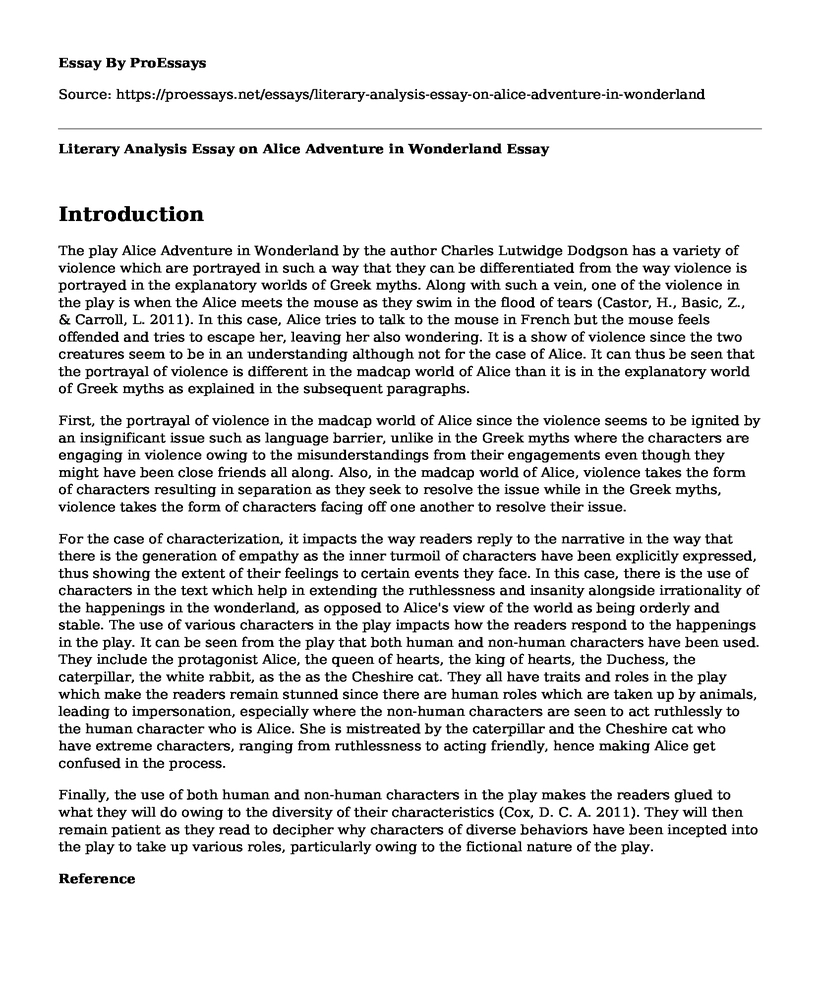Introduction
The play Alice Adventure in Wonderland by the author Charles Lutwidge Dodgson has a variety of violence which are portrayed in such a way that they can be differentiated from the way violence is portrayed in the explanatory worlds of Greek myths. Along with such a vein, one of the violence in the play is when the Alice meets the mouse as they swim in the flood of tears (Castor, H., Basic, Z., & Carroll, L. 2011). In this case, Alice tries to talk to the mouse in French but the mouse feels offended and tries to escape her, leaving her also wondering. It is a show of violence since the two creatures seem to be in an understanding although not for the case of Alice. It can thus be seen that the portrayal of violence is different in the madcap world of Alice than it is in the explanatory world of Greek myths as explained in the subsequent paragraphs.
First, the portrayal of violence in the madcap world of Alice since the violence seems to be ignited by an insignificant issue such as language barrier, unlike in the Greek myths where the characters are engaging in violence owing to the misunderstandings from their engagements even though they might have been close friends all along. Also, in the madcap world of Alice, violence takes the form of characters resulting in separation as they seek to resolve the issue while in the Greek myths, violence takes the form of characters facing off one another to resolve their issue.
For the case of characterization, it impacts the way readers reply to the narrative in the way that there is the generation of empathy as the inner turmoil of characters have been explicitly expressed, thus showing the extent of their feelings to certain events they face. In this case, there is the use of characters in the text which help in extending the ruthlessness and insanity alongside irrationality of the happenings in the wonderland, as opposed to Alice's view of the world as being orderly and stable. The use of various characters in the play impacts how the readers respond to the happenings in the play. It can be seen from the play that both human and non-human characters have been used. They include the protagonist Alice, the queen of hearts, the king of hearts, the Duchess, the caterpillar, the white rabbit, as the as the Cheshire cat. They all have traits and roles in the play which make the readers remain stunned since there are human roles which are taken up by animals, leading to impersonation, especially where the non-human characters are seen to act ruthlessly to the human character who is Alice. She is mistreated by the caterpillar and the Cheshire cat who have extreme characters, ranging from ruthlessness to acting friendly, hence making Alice get confused in the process.
Finally, the use of both human and non-human characters in the play makes the readers glued to what they will do owing to the diversity of their characteristics (Cox, D. C. A. 2011). They will then remain patient as they read to decipher why characters of diverse behaviors have been incepted into the play to take up various roles, particularly owing to the fictional nature of the play.
Reference
Castor, H., Basic, Z., & Carroll, L. (2011). Alice's adventures in Wonderland. London: Carlton.
Cox, D. C. A. (2011). Literature-Based Teaching in the Content Areas: 40 Strategies for K-8 Classrooms. Thousand Oaks: SAGE Publications.
Cite this page
Literary Analysis Essay on Alice Adventure in Wonderland. (2022, Nov 16). Retrieved from https://proessays.net/essays/literary-analysis-essay-on-alice-adventure-in-wonderland
If you are the original author of this essay and no longer wish to have it published on the ProEssays website, please click below to request its removal:
- Plot Overview: Othello by William Shakespeare
- Theme Construction in Kurosawa's Dreams
- Shakespeare Plays Annotated Bibliography
- Essay Sample on Hemingway: A New Value System for Surviving Disasters
- Essay Sample on The Ballad of Birmingham: Revealing Injustices of 1969 Church Bombings
- Essay Example on Cat in the Rain: Underappreciated Classic of the 20th Century
- Essay on William Wordsworth's Tintern Abbey: Romanticism Refuted Through Poetry







